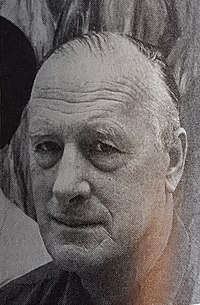Waldemar Sjölander
Waldemar Sjölander | |
|---|---|
 Waldemar Sjölander. | |
| Born | January 6, 1908 Gothenburg, Sweden |
| Died | March 18, 1988 (aged 80) Mexico City, Mexico |
| Nationality | Mexican |
| Known for | painting, printmaking, sculpture |
Gustav Waldemar Sjölander Johnson[1] (January 6, 1908 – March 18, 1988) was a Swedish painter, printmaker and sculptor, who developed most of his career in Mexico. He immigrated to the country just after World War II, after establishing himself as an artist in his native Sweden. His career included individual exhibitions in venues such as the Palacio de Bellas Artes in Mexico and the Konstakademin in Sweden, with his works held by museums in Mexico and Europe.
Life
Sjölander was born on January 6, 1908, in
His visits to Mexico impressed him and by the end of the 1930s he decided to immigrate to the country, but World War II delayed his plans. During this war, he became an officer in a cavalry regiment along Sweden's border with Finland, studying Spanish from an old grammar book in his free time.[3][4]
Sjölander became one of many fine artists that immigrated to Mexico in the 20th century. After he left his country at the end of the war, he first went to
Sjölander died in Mexico City on March 18, 1988, at the age of 80.[3]
Career
Sjölander began his artistic career in Sweden. He began creating prints, especially lithography in the mid 1940s, and to survive often had to paint cafes and other commercial establishments.[2][3] In 1944, he had an individual exhibition at the Olsen Art Gallery, then at the Modern Art Gallery in 1945 and 1946. These exhibitions made him an established artist in his home country.[3]
After arriving in Mexico,
Sjölander's works can be found in the collection of the
In addition to producing art for which he never accepted the help of a patron, Sjölander also taught at the
Sjölander's work was recognized with various distinctions during his lifetime, including Knight's Decoration First Class from his home country of Sweden in 1959, membership in the Order of Saint Michael in France in the 1960s along with membership in the Salón de la Plástica Mexicana. He received the Xipe-Totec award at the First National Sculpture Biennale in 1962 and the first sculpture prize from the Salon de la Plástica Mexicana in 1971. Retrospectives of his work include one at the Palacio de Bellas Artes in 1985, one from the Instituto Nacional de Bellas Artes in 1991 and at the Museo Dolores Olmedo in 1998.[3][4]
Artistry
Sjölander painted, sculpted and did printmaking during his career, designing over 500 of the tools he used.
The artist's work, especially his painting, is noted for its use of color. In Sweden his was a member of a group called the "Colorists of Gothenburg" as an art movement in that country, which experimented with colors not before used there. When he arrived to Mexico, nature and the colors common in Mexico were very different from his home country and changes to his art began almost immediately, although in both places nature played a dominant role.[2][3] His earlier work used bolder colors than later work, which became more subtle and delicate.[3] Fernando Gamboa wrote that "His autonomy lies in his color, in the rich hues that never shatter the surface of the painting; the balance and originality of his sculptures reveal a unique resolution of form and style.[4]
A large number of his paintings, reliefs and engraving relate to man and landscape, with only a few portraits such as one of his wife, Aurora, in 1952. His early work was more figurative, showing influence from
External links
- Waldemar Sjölander in the Ibero-American Institute (Prussian Cultural Heritage Foundation) catalogue, Berlin
- Literature by and about Waldemar Sjölander in the German National Library catalogue
References
- ^ Gustav Waldemar Sjölander
- ^ a b c d e f g "Waldemar Sjolander" (in Spanish). Mexico City: Artes e Historia magazine. Retrieved October 23, 2013.
- ^ a b c d e f g h i j k l m n o p q r s María Teresa Favela (January 2003). "Waldemar Sjolander El Gran Colorista" (PDF). Addenda (in Spanish). Mexico: CENIDIAP. Retrieved October 23, 2013.
- ^ ISBN 968-6258-56-6.
